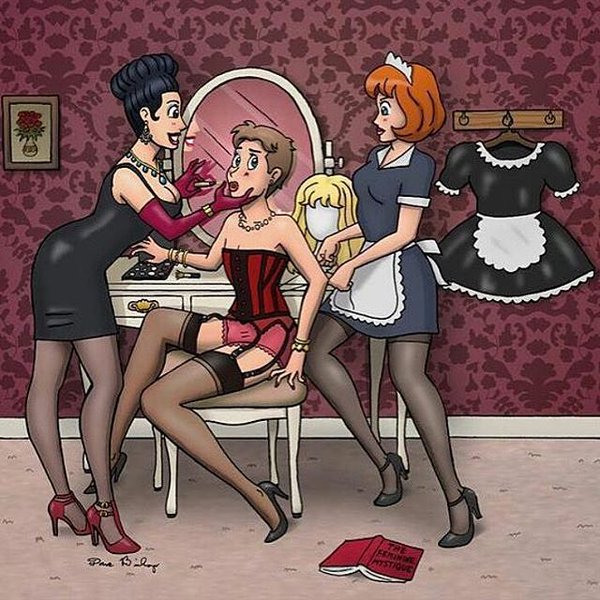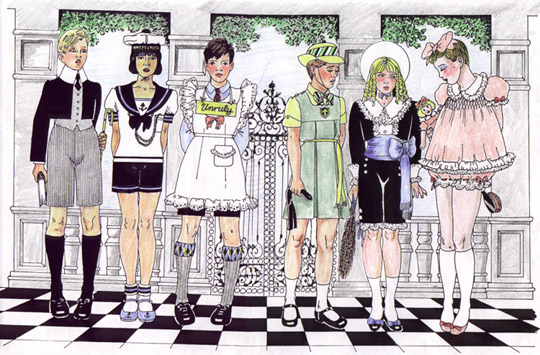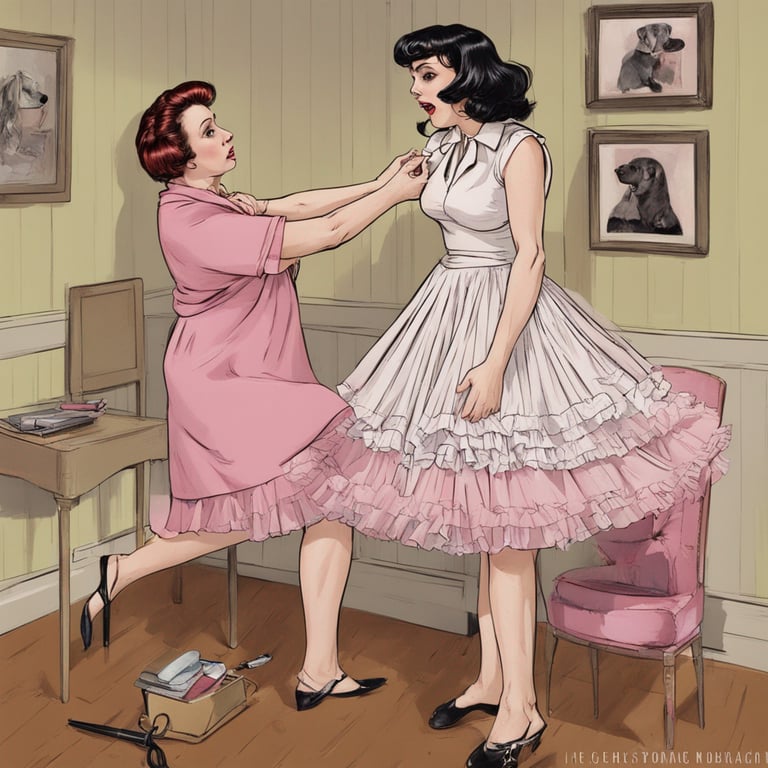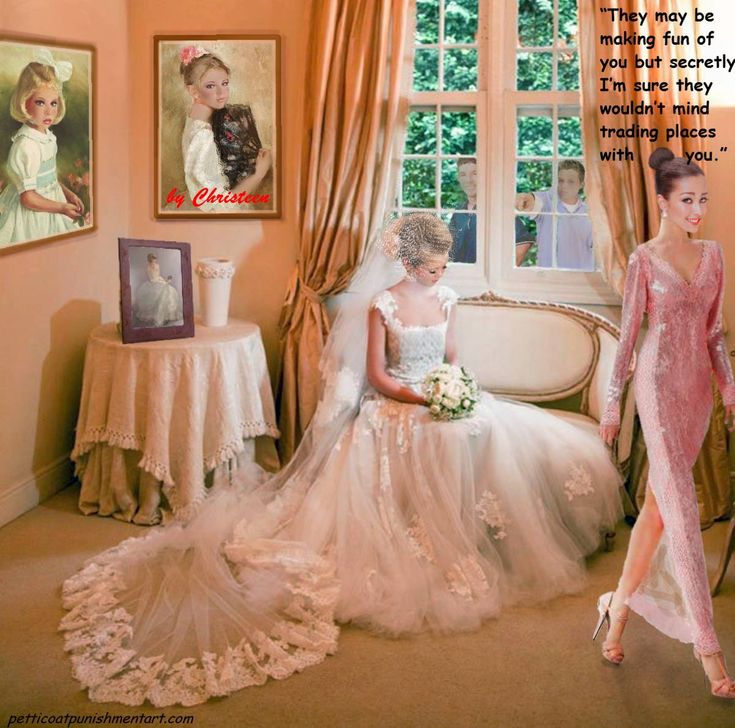Petticoat Punishment and Sissy Training for Wayward Boys
Explore how petticoat punishment, used by strict parents and guardians, has evolved into a key aspect of sissy training. Here's our complete guide.
SISSY TRAINING
Emma LaVerne
8/29/20247 min read


"Petticoat punishment" is a term that refers to a form of discipline where boys or men are compelled to wear clothing traditionally associated with females, such as petticoats, dresses, or skirts. This practice has historical roots and has been employed in various contexts, often as a method to shame, humiliate, or enforce obedience.
The concept plays on societal norms and gender expectations, leveraging the stigma attached to cross-dressing to exert control. While the practice is largely considered outdated and controversial, it provides an interesting lens through which to examine historical attitudes toward gender, authority, and discipline.
Historical Context and Origins
The origins of petticoat punishment can be traced back to the 19th and early 20th centuries, although the exact beginning is difficult to pinpoint. The Victorian era, with its strict social norms and rigid gender roles, provided fertile ground for such practices.
During this time, clothing was deeply symbolic, with specific garments assigned to each gender, signifying one's place in the social hierarchy.
Petticoat punishment was sometimes employed by strict parents, schoolmasters, or guardians who believed that forcing a boy to wear girls' clothing would correct undesirable behavior. The underlying belief was that the humiliation associated with wearing a dress would discourage the boy from repeating whatever actions had led to the punishment.
This method was often justified as a means to curb perceived effeminacy or disobedience, with the idea that boys who were "too soft" could be toughened up by experiencing the shame of being feminized.


Petticoat Punishment in Literature and Anecdotal Evidence
Literature from the 19th and early 20th centuries occasionally references petticoat punishment, often in the context of moral stories or cautionary tales.
For instance, some Victorian moral stories included accounts of boys being dressed in girls' clothing as a corrective measure for misbehavior. These stories usually conveyed a moral lesson, with the humiliation serving as a deterrent to future misdeeds.
Anecdotal evidence from personal letters, diaries, and autobiographies also sheds light on the practice. Some accounts suggest that petticoat punishment was not uncommon in certain households, particularly in Britain and the United States.
For example, in some families, a boy who had been caught misbehaving might be forced to wear his sister's clothes as a punishment, often in front of siblings or even guests, to maximize the humiliation.
Psychological and Social Implications
The psychological impact of petticoat punishment has been the subject of much debate. On one hand, proponents of the practice in the past might have argued that it was an effective deterrent against misbehavior. On the other hand, modern perspectives highlight the potential for long-lasting psychological harm. The forced cross-dressing could lead to confusion, shame, and damaged self-esteem, particularly in a society that heavily policed gender norms.
From a sociological perspective, petticoat punishment underscores the rigid gender roles that were enforced in earlier eras. The very notion that dressing a boy in girls' clothing could be a form of punishment speaks volumes about the value placed on masculinity and the fear of feminization. It reflects a time when deviations from gender norms were not just frowned upon but actively punished.
Modern Perspectives and Criticism
In contemporary times, petticoat punishment is largely viewed as an outdated and harmful practice. It is generally considered a form of psychological abuse, particularly when used on children who are not equipped to understand the complexities of gender and identity. Modern child-rearing practices emphasize positive reinforcement and non-humiliating forms of discipline, in stark contrast to the punitive measures of the past.
Moreover, today's society has a more nuanced understanding of gender as a spectrum, rather than a binary construct. The stigmatization of cross-dressing has diminished significantly, with greater acceptance of diverse gender expressions. In this context, the idea of using clothing to shame or punish someone is increasingly seen as inappropriate and damaging.
Petticoat Punishment in Popular Culture
Despite its controversial nature, petticoat punishment has occasionally appeared in popular culture, often as a plot device in stories or films that explore themes of gender and power dynamics. For example, some period dramas or comedies might depict petticoat punishment as a relic of a bygone era, highlighting the absurdity and cruelty of the practice.
In some subcultures, particularly within certain fetish communities, petticoat punishment is reinterpreted and fetishized, often divorced from its historical context of humiliation and punishment. In these contexts, it is consensually adopted as part of role-play, rather than as a means of discipline.


Petticoat Punishment Today
Petticoat punishment, while certainly not a mainstream practice, does exist as a niche fetish within the broader BDSM community. It involves using petticoats or other frilly undergarments as a tool for sensual or disciplinary spanking or other forms of light corporal punishment.
Its popularity is difficult to quantify precisely, but its presence in online communities, adult literature, and even some BDSM events suggests that it continues to hold some level of appeal for certain individuals. It's crucial to remember that any BDSM activity should be consensual, safe, and negotiated between all involved parties.
Sarah, the Sensual Submissive
"For me, petticoat punishment is all about embracing a playful, feminine form of discipline. The gentle swats and the frilly fabric create a unique blend of sensation and humiliation that's incredibly erotic. It taps into my desire to surrender control and be guided by a dominant partner, all within a safe and consensual context. The focus on petticoats adds a layer of ritual and aesthetic appeal that enhances the whole experience, making me feel cherished even in moments of playful chastisement."
David, the Dominant Disciplinarian
"I find petticoat punishment to be a particularly effective tool for maintaining order and reinforcing boundaries within my D/s dynamic. The visual contrast between the delicate undergarments and the act of spanking creates a powerful image that serves as a reminder of roles and expectations. It allows me to express my authority while still maintaining a playful and sensual atmosphere. The focus on petticoats adds a touch of old-fashioned charm that appeals to both my partner's and my own aesthetic sensibilities."
Emily, the Exploring Couple
"My partner and I discovered petticoat punishment as a way to add a new dimension to our BDSM play. It's a fun and slightly silly activity that allows us to step outside our everyday roles and explore different power dynamics. The focus on petticoats adds a touch of whimsy and eroticism that enhances the whole experience. It's a reminder that BDSM can be both playful and sensual, and it's a great way for us to connect on a deeper level while exploring our boundaries."


Key Takeaways From These Stories
Sensuality: The combination of gentle spanking and the soft, frilly fabric creates a unique sensual experience that many find erotic.
Power Dynamics: Petticoat punishment can be used to explore and reinforce power dynamics within a BDSM relationship, creating a clear visual representation of roles and expectations.
Playfulness: The focus on petticoats adds a touch of whimsy and lightheartedness to the experience, making it a fun and engaging activity for some couples.
Humiliation: For some, the act of being spanked while wearing petticoats can be a source of erotic humiliation, adding an extra layer of excitement to the experience.
Aesthetic Appeal: The visual appeal of petticoats and the ritualistic nature of the practice can enhance the overall experience for both dominant and submissive partners.
Petticoat Punishment Fiction
Petticoat punishment fiction, while not for everyone, offers a glimpse into a particular niche within the broader BDSM world. It explores themes of power, submission, gender play, and erotic humiliation, offering a unique blend of fantasy and sensuality for those who find it appealing.
The Sissy School
Premise: Often set in a strict boarding school or a domineering mother's household, boys deemed "unruly" are forced to wear petticoats and subjected to spankings as a form of behavioral correction.
Appeal: Explores themes of gender play, humiliation, and obedience. The contrast between masculine expectations and enforced femininity creates a potent dynamic.
The Regency Romance
Premise: Set in a historical context, a headstrong lady finds herself at the mercy of a stern, yet alluring, gentleman who uses petticoat spankings to tame her rebellious spirit.
Appeal: Blends classic romance tropes with BDSM elements. The historical setting adds a layer of forbidden allure and the power dynamics are heightened by societal expectations.
The Modern Power Exchange
Premise: A contemporary couple incorporates petticoat punishment into their established D/s dynamic. It becomes a playful ritual for enforcing rules and maintaining a sense of control.
Appeal: Focuses on the consensual negotiation of power within a relationship. The petticoats serve as a visual cue, enhancing the sense of submission and surrender.
The Humorous Take
Premise: Petticoat punishment is presented in a comedic light, often involving cross-dressing men or playful role-reversals.
Appeal: Uses humor to explore themes of gender and sexuality. The absurdity of the situation often leads to lighthearted and erotic scenarios.
Beyond the Page
Petticoat punishment fiction can also be found in visual mediums like comics and illustrations, where the visual contrast of frills and discipline adds to the appeal.
Fanfiction communities thrive on exploring this niche further, often taking established characters and placing them in petticoat punishment scenarios.
Petticoat punishment is a fascinating aspect of history that offers insight into the ways in which gender norms and societal expectations have been enforced. While it may have been employed as a tool for discipline in the past, its legacy is one of psychological harm and reinforcement of rigid gender roles. The practice still has a strong following, however, especially with regards to sissy training. Many Masters and Mistresses use petticoats as a way to instil compliance and it is often used as a stepping stone to sissy training and even full forced feminization.


